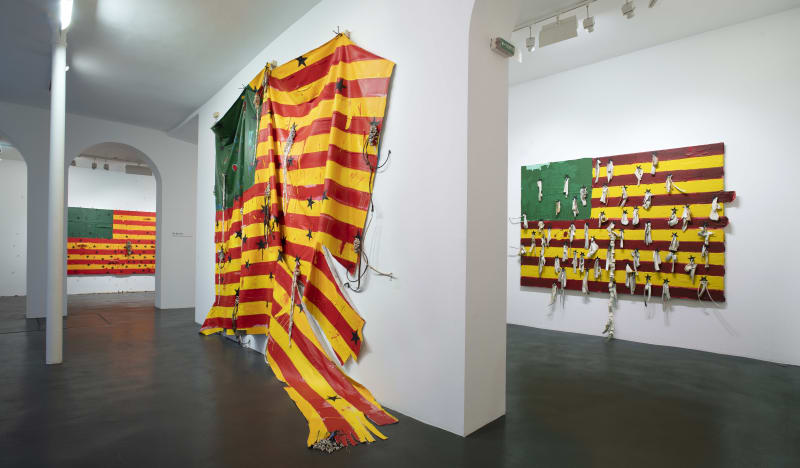Galerie Nathalie Obadia is very pleased to present Africa: Renversante, Renversée, Nú Barreto’s first solo show at the gallery.
Born in 1966 in São Domingos, Guinea-Bissau, Nú Barreto is a major figure of the contemporary African scene. He incorporates the different periods of the African continent’s highly emotional history in his works, using a variety of mediums, including the paintings that will be shown in this exhibition.
In 2009, Nú Barreto began a new series of paintings that would revisit the American flag with Pan-African colors. Desunited States of Africa is a series of nine works, included in this exhibition. Here, the artist adopts a new approach and questions a variety of themes, especially that of the disunion of the African people.
By borrowing the composition of the American flag, thus referencing Jasper Johns’s American Flag (1954-1955), Nú Barreto inscribes himself in the tradition of artists who use the visual power of symbols to highlight social issues. Let us also mention the artist David Hammons, who, with African-American Flag (1990), questioned public opinion on the African-American cultural identity. By appropriating the color palette of the UNIA (Universal Negro Improvement Association) flag, he suggested a hybrid reinterpretation of it. Hammons’s historic flag would inform the political dimension of Barreto’s work.
Nú Barreto explores the African continent’s culture and history. The paintings in his series Desunited States of Africa are all made with the colors of the flags of African nations: red, green, and black. They are composed of fifty-four stars, one for each African country. Whether scattered across the canvas, torn from the flag like in Dépités or suspended like in Déraciné, the placement of these symbols represents the disorder created by the conflicts between the states.
Beyond the political divergences that separate us from the utopian vision of a united African nation, it is also an entire continent that faces its sometimes-bloody heritage. The work Yako (an Akan term originating from the Ivory Coast, which means “to empathize with pain”) is a flag dotted with sockets that pierce the canvas and are placed directly on the floor. Here, Nú Barreto echoes the fratricidal wars, the many coups d’état that took place in the course of the 20th century. Similarly, the use of bones in some of his works accentuates the violence of his message and condemns the African genocides.
Vandalisme coloré, a flag pricked with a multitude of pins, like a voodoo doll, summarizes the populations’ enduring pain and stigmata. Despite the hardships, Nú Barreto underlines the intellectual and cultural resources that are available to the African nations. Like a message of hope, books by African authors are suspended on the canvas of La Source and present Africa as a reservoir of optimism.
The work of Nú Barreto seems to be constantly close to boiling point. His work is anchored as much in History as it is in current events. The artist calls our attention with his actions, his hand-to-hand combat with his works: he somehow makes us feel a certain violence and rage, both visual and metaphorical, while also continuing his quest for a singular aesthetic. The use of cowry shells, sockets, and other knickknacks transforms these flags into sculptures that are reminiscent of El Anatsui’s textile works, which are made of thousands of crushed bottlecaps. Nú Barreto’s flag paintings become outlets, windows onto the world, witnesses of a people’s history.

